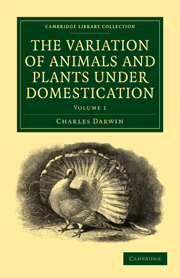Book contents
- Frontmatter
- Contents
- LIST OF ILLUSTRATIONS
- INTRODUCTION
- CHAPTER I DOMESTIC DOGS AND CATS
- CHAPTER II HORSES AND ASSES
- CHAPTER III PIGS — CATTLE — SHEEP — GOATS
- CHAPTER IV DOMESTIC RABBITS
- CHAPTER V DOMESTIC PIGEONS
- CHAPTER VI PIGEONS—continued
- CHAPTER VII FOWLS
- CHAPTER VIII DUCKS — GOOSE — PEACOCK — TURKEY — GUINEA-FOWL — CANARY-BIRD — GOLD-FISH — HIVE-BEES—SILK-MOTHS
- CHAPTER IX CULTIVATED PLANTS: CEREAL AND CULINARY PLANTS
- CHAPTER X PLANTS continued — FRUITS — ORNAMENTAL TREES — FLOWERS
- CHAPTER XI ON BUD-VARIATION, AND ON CERTAIN ANOMALOUS MODES OF REPRODUCTION AND VARIATION
CHAPTER IX - CULTIVATED PLANTS: CEREAL AND CULINARY PLANTS
Published online by Cambridge University Press: 05 October 2010
- Frontmatter
- Contents
- LIST OF ILLUSTRATIONS
- INTRODUCTION
- CHAPTER I DOMESTIC DOGS AND CATS
- CHAPTER II HORSES AND ASSES
- CHAPTER III PIGS — CATTLE — SHEEP — GOATS
- CHAPTER IV DOMESTIC RABBITS
- CHAPTER V DOMESTIC PIGEONS
- CHAPTER VI PIGEONS—continued
- CHAPTER VII FOWLS
- CHAPTER VIII DUCKS — GOOSE — PEACOCK — TURKEY — GUINEA-FOWL — CANARY-BIRD — GOLD-FISH — HIVE-BEES—SILK-MOTHS
- CHAPTER IX CULTIVATED PLANTS: CEREAL AND CULINARY PLANTS
- CHAPTER X PLANTS continued — FRUITS — ORNAMENTAL TREES — FLOWERS
- CHAPTER XI ON BUD-VARIATION, AND ON CERTAIN ANOMALOUS MODES OF REPRODUCTION AND VARIATION
Summary
I shall not enter into so much detail on the variability of cultivated plants, as in the case of domesticated animals. The subject is involved in much difficulty. Botanists have generally neglected cultivated varieties, as beneath their notice. In several cases the wild prototype is unknown or doubtfully known; and in other cases it is hardly possible to distinguish between escaped seedlings and truly wild plants, so that there is no safe standard of comparison by which to judge of any supposed amount of change. Not a few botanists believe that several of our anciently cultivated plants have become so profoundly modified that it is not possible now to recognise their aboriginal parent-forms. Equally perplexing are the doubts whether some of them are descended from one species, or from several inextricably commingled by crossing and variation. Variations often pass into, and cannot be distinguished from, monstrosities; and monstrosities are of little significance for our purpose. Many varieties are propagated solely by grafts, buds, layers, bulbs, &c., and frequently it is not known how far their peculiarities can be transmitted by seminal generation. Nevertheless some facts of value can be gleaned; and other facts will hereafter be incidentally given. One chief object in the two following chapters is to show how generally almost every character in our cultivated plants has become variable.
- Type
- Chapter
- Information
- The Variation of Animals and Plants under Domestication , pp. 305 - 331Publisher: Cambridge University PressPrint publication year: 2010First published in: 1868
- 1
- Cited by



